Analogue and Digital Telecommunication In the subject Technology, the topic Analogue and Digital Telecommunication explores how information is transmitted through signals. While analogue communication uses continuous signals, digital communication relies on binary codes for faster and more reliable transmission.
Previous year Questions
| Year | Question | Marks |
| 2018 | (a)Distinguish between “Sky wave” and “Space wave” propagation in a communication system.(b) Draw a schematic diagram showing the (i) Ground wave, (ii) Sky wave,(iii) Space wave propagation of electromagnetic waves. (c) Write the frequency range for each of the following :(i) Standard Amplitude Modulated (AM) Broadcast(ii) Television(iii) Satellite Communication | 10M |
| 2018 | Distinguish between Analog and digital signals. | 2M |
| 2016 Spl exam | What do you understand about the communication system ? Give a block diagram of the communication system and explain its elements. ? | 10M |
Communication Systems
A communication system is a setup or network that enables the exchange of information(data, voice, video, etc.) between a sender and a receiver using a specific medium and protocol.
Applications
- Telephony: Mobile and landline voice communication.
- Broadcasting: Radio, TV, and streaming services.
- Internet Communication: Email, instant messaging, video conferencing, and social media.
- Military and Government Communication: Secure communication for national security and public safety.
- Healthcare: Telemedicine, remote patient monitoring, and digital health systems.
- Business: E-commerce, cloud communication, and customer support through call centers.
ELEMENTS OF A COMMUNICATION SYSTEM
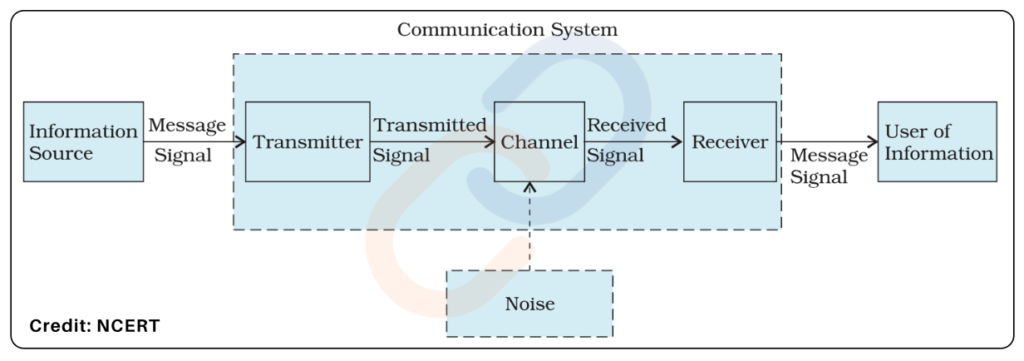
Key Components of a Communication System
Information Source:
- Purpose: Generates the original message or data to be transmitted. Examples:
- Human voice in a phone call.
- Data from sensors in IoT devices
- Video or audio files for streaming.
Transmitter:
- The transmitter is responsible for converting the information into a signal that can be transmitted through a medium.
- Processes in a Transmitter:
- Transducer: A device that converts the input signal (e.g., sound, light, or other physical phenomena) into an electrical signal. Example: A microphone converts sound waves into electrical signals. (Encoding)
- Modulation: The process of superimposing the message signal onto a high-frequency carrier wave for transmission over long distances.
- Oscillator: : Generates the high-frequency carrier wave required for modulation.
- Amplification: The process of increasing the modulated signal strength to overcome attenuation, using an amplifier.
- Signal radiation through Antenna: Converts the electrical signal into electromagnetic waves and radiates them into space for transmission. Example: TV, radio, or mobile antennas.
- Processes in a Transmitter:
Communication Channel:
- Purpose: The medium through which the signal travels from the transmitter to the receiver.
Types of Channels:
- Wired Channels:
- Use physical connections like copper cables, optical fibers, or coaxial cables.
- Example: LAN Ethernet cables.
- Wireless Channels:
- Use electromagnetic waves (radio, microwave, infrared).
- Example: Wi-Fi, mobile networks.
- Challenges:
- Noise: Unwanted signals that interfere with the message signal, causing distortion.
- Signal Attenuation: Loss of signal strength over long distances.
Receiver:
- Purpose: Recovers the original message from the transmitted signal.
- Processes in a Receiver:
- Demodulation: Separates the message signal from the carrier wave.
- Decoding: Converts the received signal back into its original form (e.g., sound, text, or video).
- Examples:
- A speaker in a phone call.
- Decoders in TVs or streaming devices.
- Outcome: The message is restored for the destination.
Destination:
- Purpose: The final endpoint where the information is delivered.
- Examples:
- A person listening to a phone call.
- A server receiving data from a client device.
Modes of Communication:
- Point-to-point communication involves a direct link between a single transmitter (sender) and receiver (e.g., telephone calls, video conferencing).
- Broadcast communication involves one transmitter and multiple receivers (e.g., radio and television).
- Multicast Communication: One sender communicates with a group of receivers, typically in real-time (e.g., live streaming, webinars).
Other Basic Terminology:
- Signal: The electrical representation of information, which can be either analog (continuous) or digital (discrete).
- Repeater: A device that amplifies and retransmits signals to extend the communication range. It combines both a receiver and transmitter.
- Range: The maximum distance over which the signal can be received with sufficient strength.
- Bandwidth: The frequency range that the equipment operates in or the range occupied by the signal.
Bandwidth
Bandwidth refers to the range of frequencies that a transmission medium (such as a cable or wireless spectrum) can carry. It determines how much data can be transmitted over a network in a given amount of time. More bandwidth means more data can be sent, and vice versa.
Analog Signal Bandwidth
- Definition: The bandwidth of an analog signal is the range of frequencies the signal occupies.
- Units: Measured in Hertz (Hz), representing the frequency range.
- For example, if a signal occupies frequencies between 1 MHz and 10 MHz, the bandwidth is 9 MHz.
- Example
- Human Speech: Typically has a bandwidth of about 4 kHz.
- AM Radio: Uses a bandwidth of about 10 kHz.
- FM Radio: Uses about 15 kHz bandwidth, and the signal quality is significantly better than AM because it has a larger bandwidth and better noise immunity.
- Video Signal: The bandwidth is much larger, at 4.2 MHz.
- TV Broadcast Channel: Typically has a bandwidth of 6 MHz.
Digital Signal Bandwidth
- Definition: In digital signals, bandwidth refers to the quantity of information that can be transmitted per second.
- Units: Measured in bits per second (bps).
- A channel with more bandwidth can carry more data, leading to higher data transmission speeds.
- Example:
- Modems: A typical modem has bandwidths of 32 kbps, 64 kbps, or 128 kbps, which defines the speed at which digital signals can be transmitted over analog telephone lines.
Different transmission media offer varying bandwidths:
- Coaxial Cable: 750 MHz, typically operates below 18 GHz.
- typically used for medium-range communication like cable TV and internet.
- Free Space (Radio Waves): Frequency range from hundreds of kHz to GHz, allocated for services like AM/FM radio and satellite communication.
- Fiber Optic Cable:Provides a massive bandwidth in the range of 1 THz to 1000 THz, offering the highest data transfer speeds for long-distance and high-capacity communication.
Important Wireless Communication Frequency Bands :
- AM Broadcast: 540-1600 kHz
- FM Broadcast: 88-108 MHz
- TV: VHF (54-72 MHz, 76-88 MHz) & UHF (174-216 MHz, 420-890 MHz)
- Cellular: 896-901 MHz (Mobile to base station), 840-935 MHz (Base station to mobile)
- Satellite: 5.925-6.425 GHz (Uplink), 3.7-4.2 GHz (Downlink)
- The International Telecommunication Union (ITU) manages global frequency allocations.
Additional Concepts:
- Noise in Communication Systems:
- Noise refers to any unwanted disturbance or interference that degrades the quality of the transmitted signal. It can occur at any stage of communication: during signal transmission, reception, or processing.
- Types of Noise:
- Thermal Noise: Random electrical noise generated by the movement of charge carriers in a conductor.
- Interference: Signals from other communication systems that disrupt the signal.
- Crosstalk: Unwanted transfer of signals between communication channels.
- Impulse Noise: Sudden, short-duration noise spikes, often due to electrical or mechanical faults.
- Impact: Noise can degrade the quality of the transmitted message.
- Signal-to-Noise Ratio (SNR): This ratio is a measure of the strength of the desired signal relative to the noise level. Higher SNR means clearer signal transmission.
- Solution: Use noise-canceling techniques like filters and error correction codes.
- Signal Loss (Attenuation):
- Definition: Reduction in signal strength as it travels through the medium.
- Solution: Use repeaters or amplifiers in wired systems or stronger antennas in wireless systems.
Real-World Example: Mobile Phone Communication
- When you make a call:
- Your voice (information source) is converted into an electrical signal by the phone’s microphone (transmitter).
- The signal travels through the air (wireless channel) to a nearby cell tower.
- The cell tower relays the signal to the receiver’s phone (receiver), which converts the electrical signal back into sound for the listener (destination).
Analogue Signal Vs Digital Signal
| Aspect | Analogue Signal | Digital Signal |
| Definition | Continuous signal that represents data through varying amplitude, frequency, or phase. | Discrete signal that encodes data in binary form (0s and 1s). |
| Nature | Continuous in time and amplitude. | Discrete in time and amplitude. |
| Representation | Represented as a sine wave. | Represented as a square wave. |
| Data Values | Infinite possible values within a range. | Finite values (e.g., 0 and 1 in binary). |
| Examples | Sound waves, light intensity, temperature. | Computer data, digital audio, and video signals. |
| Transmission | Prone to noise and distortion during transmission. | Less prone to noise due to discrete encoding. |
| Processing | Difficult to process; requires complex hardware for amplification. | Easier to process; can use logic circuits and error correction. |
| Noise Sensitivity | Highly sensitive to noise; noise directly alters the signal. | Less sensitive to noise; errors can often be corrected. |
| Storage | Stored on analog media like magnetic tapes or vinyl records. | Stored on digital media like hard drives, SSDs, or CDs. |
| BandwidthConsumption | Requires more bandwidth for high-quality signals. | Requires less bandwidth compared to analog signals for the same data. |
| Flexibility | Less flexible in editing or modifying signals. | Highly flexible; easy to compress, edit, and manipulate digitally. |
| Applications | Used in traditional radios, TV broadcasts, and analog clocks. | Used in computers, smartphones, digital communication, and DVDs. |
Transmission Media and Propagation
Transmission Media
What is Transmission Media?
- Transmission media refers to the physical or logical pathway through which data is transmitted from one location to another.
- Transmission media can be broadly divided into guided and unguided categories.
Guided Media (Wired)
Guided media are physical pathways that guide the signal along a specific route. They require physical cables or conductors. The primary types of guided media are:
Parallel Conductors
- Consists of two parallel conductors separated by air or dielectric medium.
- Used in Telephony.
- prone to radiation at high frequencies.
Twisted Pair Cables:
- Twisted pair cables consist of pairs of copper wires twisted together to reduce electromagnetic interference.
- Applications: Used in telephone lines, Ethernet networks, and local area networks (LANs).
- Advantages: Low cost, easy installation, widely used.
- Disadvantages: Limited bandwidth, susceptible to interference and attenuation.
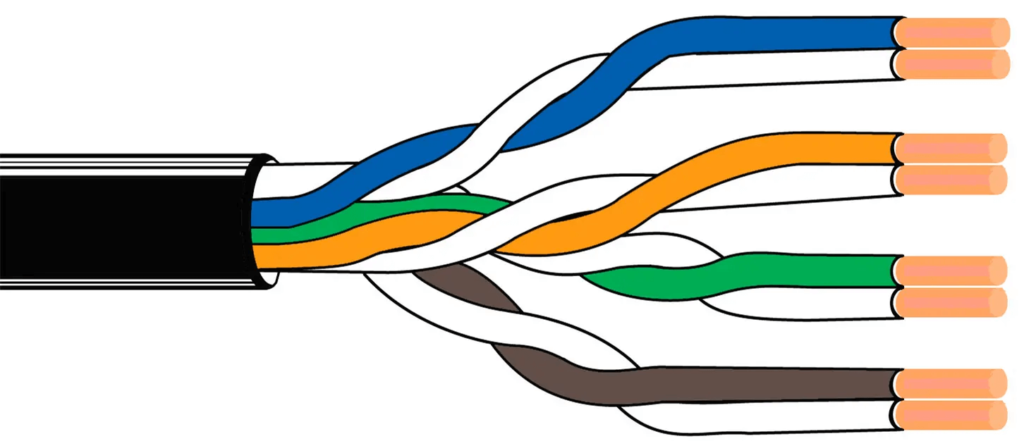
Coaxial Cables(High-Frequency Transmission):
- Description: Coaxial cables consist of a central conductor, an insulating layer, a metallic shield, and an outer insulating layer.
- Applications: Used in cable television (CATV), broadband internet connections.
- For Frequencies ≤ 3 GHz: Minimizes radiation losses.
- Advantages: Higher bandwidth than twisted pair cables, better shielding against interference.
- Limitation: Dielectric resistance decreases with frequency, limiting coaxial cables to up to 40 GHz.
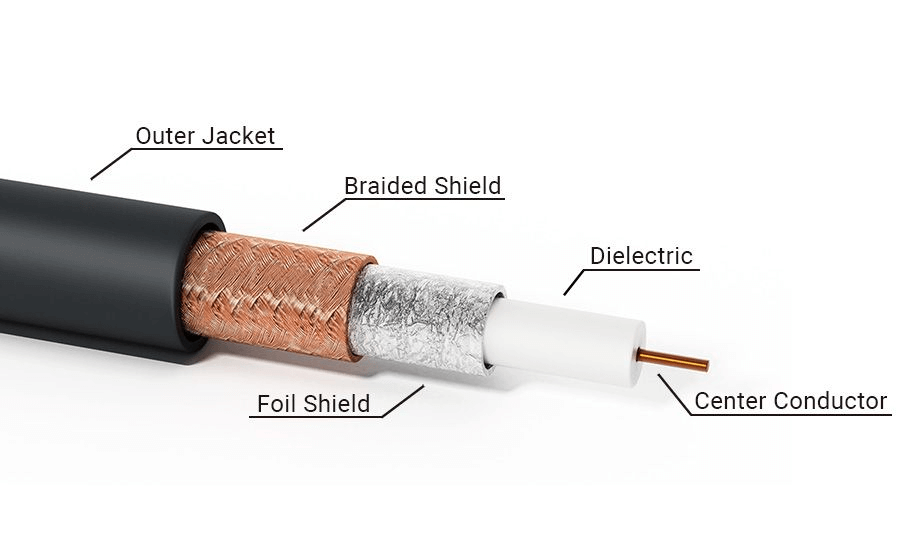
Waveguides (Beyond 40 GHz)
- Used for Frequencies Above 40 GHz.
- At frequencies > 300 GHz, the dimensions of waveguides become too small (~4 mm), presenting practical challenges.
- Solution: Optical fibers are used for guided wave transmission above 300 GHz.
Fiber Optic Cables:
- Invention of Laser (1960): Revolutionized communication technology by enabling the transmission of signals via optical fibers.
- Communication Capacity: Higher frequency regions (like visible light) offer much greater communication capacity than lower frequencies (e.g., microwave in metallic conductors).
- Multiplexing: The technique used to transmit multiple messages simultaneously over the same pathway, increasing communication efficiency.
- Fiber optic cables consist of strands of glass or plastic that carry signals as pulses of light. The fibers are coated with layers of cladding to prevent signal loss.
- Applications: Used in high-speed internet connections, long-distance communication (e.g., undersea cables), and medical imaging systems.
- Advantages: Extremely high bandwidth, immune to electromagnetic interference, long transmission distances without signal loss.
- Disadvantages: High cost, difficult to install and maintain, fragile.
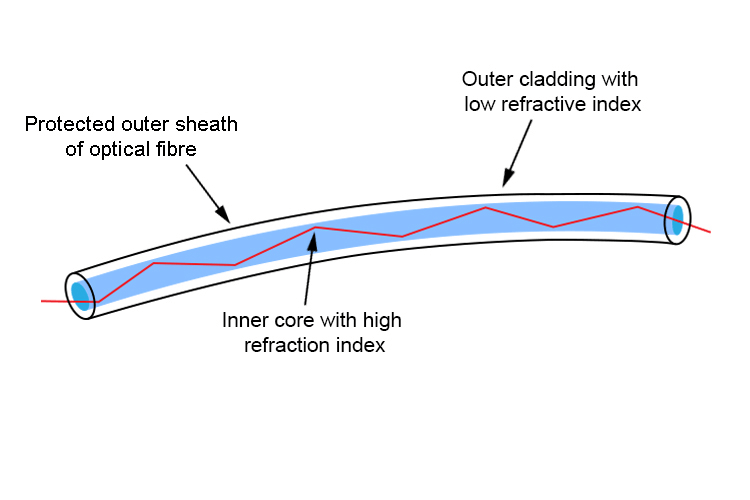
Step-Index Optical Fibre
- Structure:
- Core: Cylindrical central glass or plastic with a refractive index n1n1.
- Cladding: Same material but with slightly lower refractive index n2n2 (about 1% lower than the core).
- Coating: Protective plastic outer layer.
- Light Propagation:
- Light from the core (higher refractive index n1) strikes the core-cladding interface ( higher refractive index n1) at a critical angle and undergoes total internal reflection.
- Critical Angle:

- Total Internal Reflection : Light gets guided through the core via repeated internal reflections at the core-cladding interfaces.
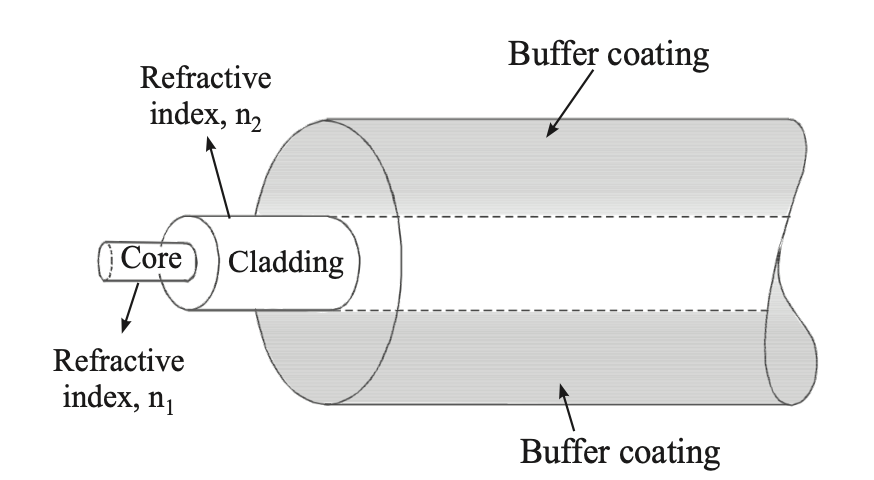
Advantage :
- High Bandwidth
- Low Attenuation: Minimal loss in intensity of the light signal due to total internal reflection.
- Immunity to EMI: Resistant to electromagnetic interference for stable transmission.
- Lightweight and Compact
Unguided Media (Wireless)
Unguided media (or wireless media) involve the transmission of signals through the air or space without any physical medium. The primary types of unguided media are:
- Radio Waves: They can cover short to long distances depending on the frequency range and the power used.
- Applications: Used in AM/FM radio broadcasting, Wi-Fi, Bluetooth, cellular networks, and satellite communication.
- Disadvantages: Limited bandwidth, susceptibility to interference, range limitations.
- Microwaves:
- Microwaves are high-frequency radio waves used for point-to-point communication, such as satellite links and microwave towers.
- Advantages: Higher bandwidth than radio waves, suitable for high-data-rate transmission.
- Disadvantages: Requires line-of-sight, susceptible to weather conditions (rain, fog).
- Infrared (IR):
- Infrared radiation is used for short-range communication by transmitting signals using light waves.
- Applications: Remote controls, short-range communication between devices (e.g., infrared ports in laptops).
- Disadvantages: Short transmission range, line-of-sight required, limited to low data rates.
- Satellite Communication:
- This type of communication uses a combination of microwave and radio wave frequencies.
- Applications: Global communication, TV broadcasting, GPS, and weather monitoring.
Characteristics of Transmission Media
- Bandwidth: High-bandwidth media can support faster data transmission rates.
- Fiber optic cables offer the highest bandwidth, followed by coaxial cables, while twisted pair cables have the lowest bandwidth.
- Attenuation: Fiber optics experience minimal attenuation, while twisted pair cables and coaxial cables experience more attenuation over longer distances.
- Interference and Noise: Shielding in cables (e.g., STP cables) helps reduce interference, and fiber optics are immune to electromagnetic interference.
Choosing the Right Transmission Media
- For long-distance, high-speed communication: Fiber optics are the best choice due to their high bandwidth and low attenuation.
- For local area networks: Twisted pair cables (especially Ethernet) are commonly used due to their affordability and ease of installation.
- For mobile communication: Wireless technologies, such as radio waves (for cellular communication) and microwaves (for satellite links), are preferred for their flexibility and coverage.
Signal Propagation and Modulation
The signal travels through a medium and can experience various phenomena, such as attenuation, reflection, and diffraction, which affect its quality and range.
Types of Signal Propagation
The propagation of signals can be categorized into three main types based on the characteristics of the signal and the medium it travels through:
| Description | Ground Wave | Sky Wave | Space Wave |
| Frequency Range | 300 kHz – 3 MHz (useful for short-range communication). | 3 MHz – 30 MHz. | 30 MHz – 300 MHz. |
| Mode of Propagation | Waves travel along the surface of the Earth and can bend around corners of objects but are affected by the terrain. | Electromagnetic waves travel upwards, reflect off the ionosphere, and return to Earth. | Space waves propagate directly from the transmitter to the receiver, typically in line-of-sight communication. |
| Key Characteristics | * Affected by ground material properties (conductivity, refractive index, dielectric constant). * Better propagation over sea than desert. * Suitable for short-range communication. | * The Ionosphere acts as an invisible electromagnetic mirror. (Transparent to optical frequencies, but reflects electromagnetic radiation at radio frequencies.) * Reflection depends on the ionosphere’s density and height. * Communication delay of 6.8 – 10 ms per reflection. * Ideal for long-distance (short-wave) communication (e.g., international broadcasting). | * Direct wave propagation is more dominant. * Space waves are best for high-frequency signals (above 30 MHz), which can travel in straight lines (line-of-sight). * These waves can be blocked by obstacles (e.g., mountains, buildings), which is why line-of-sight communication is required for effective propagation. |
| Distance | Short to medium-range (up to 300 km) | Long-range (hundreds/thousands of km) | Long-range (global with satellites) |
| Effect of Terrain | Affected by obstacles | Less affected by terrain | Requires clear line of sight |
| Diagram |
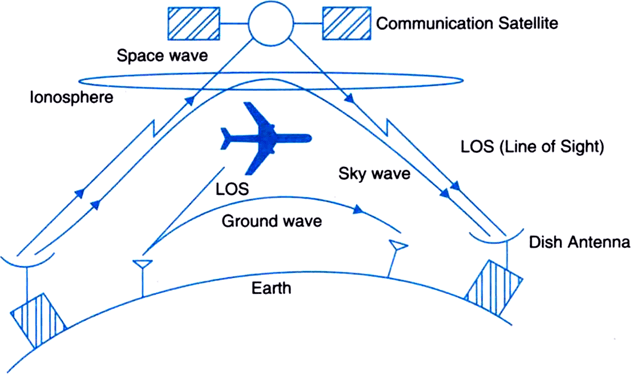
Satellite Communication:
- Modulated carrier waves are sent to a satellite, amplified, and retransmitted to Earth at a different frequency.
- Satellites amplify the signal and avoid interference by transmitting at different frequencies.
- Uplink: Transmitting modulated carrier waves to the satellite.
- Downlink: Satellite amplifies the received signal and retransmits it to Earth at a different frequency to avoid interference.
- Communication Capacity
- Above 10 MHz: The ionosphere does not reflect higher frequencies; hence, satellite communication is used for frequencies above 30 MHz.
- Space Wave vs Satellite Communication
- Space Wave Propagation: Used for higher frequencies (above 30 MHz), but limited by line-of-sight.
- Satellite Communication: Used for long-range communication with frequencies above 30 MHz, such as TV transmission (50 – 1000 MHz).
- Satellite Orbits
- Geostationary Orbit: No need for antenna adjustments as the satellite stays in a fixed position.
- Polar Circular Orbit: Passes over the poles with an inclination of 90°.
- Highly Elliptical Inclined Orbit: Inclined at 63° for communications in high-altitude regions.
- Example: Recently announced Reliance JioSpaceFiber: India’s first satellite-based gigabit broadband service; Elon Musk’s Starlink
- JioSpace Fiber uses medium Earth orbit (MEO) satellites, while Starlink uses low Earth orbit (LEO) satellites.
- Advantages- Global coverage, Easily Scalable, More Secure, Reliable communication, Low Latency.
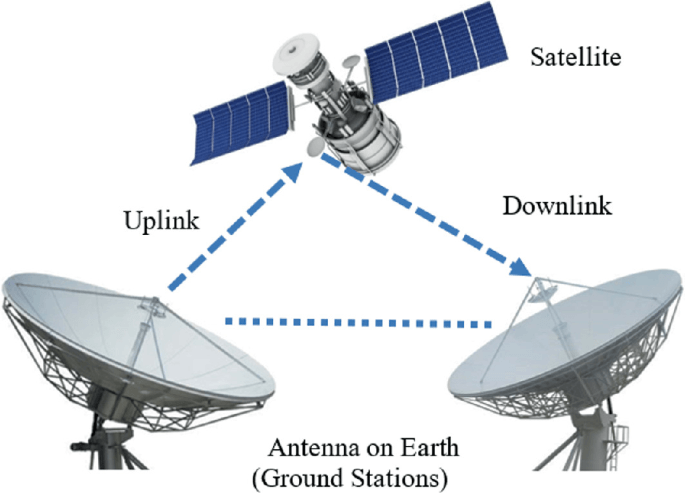
Modulation in Telecommunications
- What is Modulation?
Modulation is the process of altering the characteristics of a carrier wave (such as amplitude, frequency, or phase) in accordance with the baseband signal (the information to be transmitted). It allows the signal to be transmitted efficiently over the communication medium. - Types of Modulation: There are three primary types of modulation.
- Amplitude Modulation (AM): AM involves varying the amplitude of the carrier wave while keeping its frequency and phase constant.
- Examples → AM Radio: Broadcasts audio signals using varying amplitude.
- Advantages: Simple and inexpensive to implement.
- Disadvantages: Susceptible to noise and interference, inefficient use of power.
- Frequency Modulation (FM): FM varies the frequency of the carrier wave while maintaining a constant amplitude.
- Applications: FM radio, television audio broadcasting, two-way radio communication.
- Advantages: Better sound quality and noise immunity compared to AM.
- Disadvantages: Requires a larger bandwidth than AM.
- Phase Modulation (PM): In PM, the phase of the carrier wave is varied according to the baseband signal.
- Applications: Used in digital communication systems, satellite communication.
- Advantages: Better noise immunity than AM.
- Disadvantages: More complex to implement and process.
- Digital Modulation Techniques:
- In digital communication, modulation is used to encode binary data onto a carrier wave for transmission (e.g., using ASK, FSK, or PSK modulation techniques).
- Key Techniques:
- ASK (Amplitude Shift Keying): Transmits data by varying the amplitude of the signal.
- FSK (Frequency Shift Keying): Transmits data by varying the frequency of the signal.
- PSK (Phase Shift Keying): Transmits data by varying the phase of the signal.
- Amplitude Modulation (AM): AM involves varying the amplitude of the carrier wave while keeping its frequency and phase constant.
Types of Communication Systems
Based on Communication Medium:
Wired Communication:
Uses physical mediums like cables for data transmission.
- Examples:
- Copper cables (landline telephones, DSL connections).
- Optical fibers (high-speed internet, undersea communication cables).
- Advantages:
- Secure and reliable.
- High-speed data transfer (especially with optical fibers).
- Disadvantages:
- Limited mobility.
- Installation and maintenance costs.
Wireless Communication:
Uses electromagnetic waves (radio, microwave, infrared) for transmission.
- Examples:
- Wi-Fi, cellular networks (4G, 5G), Bluetooth.
- Satellite communication (GPS, TV broadcasting).
- Advantages:
- Enables mobility and wide coverage.
- Easier deployment in remote areas.
- Disadvantages:
- Prone to interference and security issues.
- Signal attenuation over long distances.
Based on Direction of Communication:
- Simplex Communication: Data flows in one direction only, from sender to receiver. Examples: Television broadcasting, radio transmission.
- Advantages: Simple and cost-effective.
- Disadvantages: No feedback or interaction possible.
- Half-Duplex Communication: Data flows in both directions, but one direction at a time. Examples: Walkie-talkies, two-way radios.
- Advantages: Allows two-way communication.
- Disadvantages: Slower compared to full-duplex systems.
- Full-Duplex Communication:
- Definition: Data flows in both directions simultaneously.
- Examples: Mobile phones, video calls.
- Advantages: Fast and efficient communication.
- Disadvantages: More complex and expensive infrastructure.
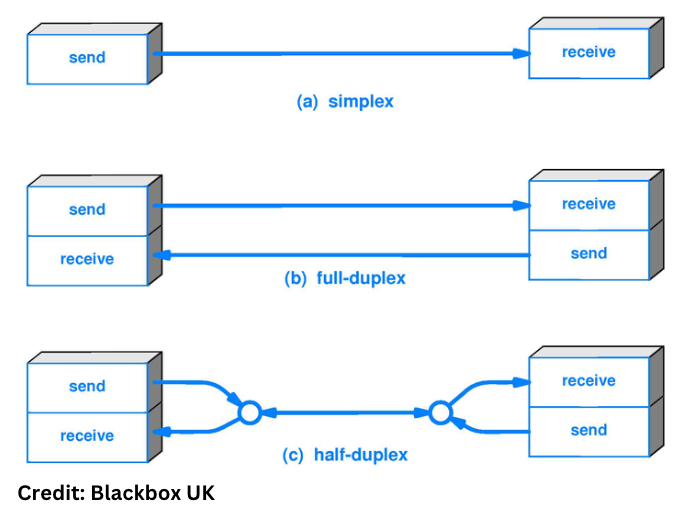
Based on Transmission Mode
Analog Communication Systems
- Definition: Analog communication systems transmit continuous signals that vary in amplitude, frequency, or phase to convey information. The information is encoded into the carrier wave, which then travels through a transmission medium (e.g., air, wires).
- Key Features:
- Continuous signals.
- Susceptibility to noise and interference.
- Limited bandwidth compared to digital systems.
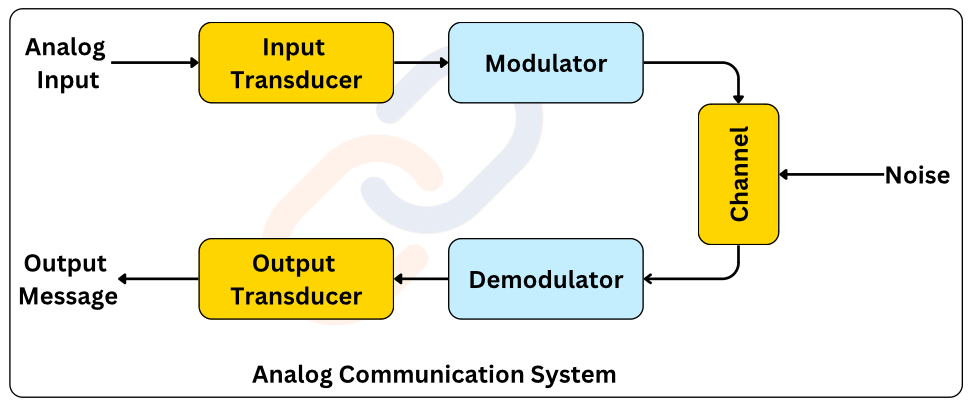
Components of Analog Communication Systems
- Transmitter:Modulates and amplifies the signal for transmission.
- Key components: Information source (e.g., voice or video), modulator (modulates the carrier wave), and amplifier (boosts the signal power for transmission).
- Transmission Medium: Medium for signal travel (e.g., coaxial cables, radio waves).
- Receiver: Demodulates and filters the signal to extract information.
- Key components: Demodulator (extracts the information from the modulated signal), filter (removes noise), and speaker/display (converts the received signal into a usable form for the end user).
Types of Analog Modulation Techniques:
- Amplitude Modulation (AM)
- Frequency Modulation (FM)
- Phase Modulation (PM)
Bandwidth Requirements for Analog Communication
- AM: Bandwidth = 2 × highest frequency of the input signal.
- FM: Requires more bandwidth, dependent on frequency deviation and modulation index.
Noise Impact: Analog signals are prone to distortion from noise, reducing communication quality.
- Signal-to-Noise Ratio (SNR): A higher SNR means better quality in analog communication, with less noise impacting the signal.
Advantages and Disadvantages of Analog Communication
- Advantages:
- Simple and cost-effective Technology
- Continuous Transmission: suitable for real-time transmission, such as voice communication.
- Disadvantages:
- Limited Bandwidth: Analog signals require a wide bandwidth to transmit complex data without degradation.
- Susceptibility to Noise
- Inefficiency: Analog systems are less efficient compared to digital systems, especially in terms of noise immunity and signal integrity over long distances.
Applications of Analog Communication Systems
- Broadcasting: AM/FM radio, analog TV.
- Telephony: Early telephone systems.
- Television: Traditional analog TV signals.
Digital Communication
Digital communication transmits data as discrete digital signals (0s and 1s) over a medium using encoding methods. Examples: Internet, mobile communication, digital TV.
Basic Process of Digital Communication:
- Source: Information to be transmitted (e.g., text, audio, video).
- Source Encoding: Converts the information into binary form (e.g., ASCII for text, PCM for audio).
- Channel Encoding: Adds error-detection and correction codes to improve reliability.
- Modulation: Maps the binary data onto carrier signals for transmission.
- Transmission: Signal travels through a channel (wired or wireless).
- Reception and Decoding: The receiver demodulates and decodes the signal to retrieve the original information.
Key Processes in Digital Communication
- Sampling (Analog-to-Digital Conversion):
- Sampling is the process of converting a continuous-time analog signal into a discrete-time signal. Example: Voice signals in telephone systems are sampled at 8 kHz.
- Quantization:
- Quantization involves mapping the sampled values of the signal to the nearest predefined levels.
- Encoding:
- The quantized values are converted into binary codes for digital transmission.
- Example: Pulse Code Modulation (PCM) is commonly used for encoding voice signals.
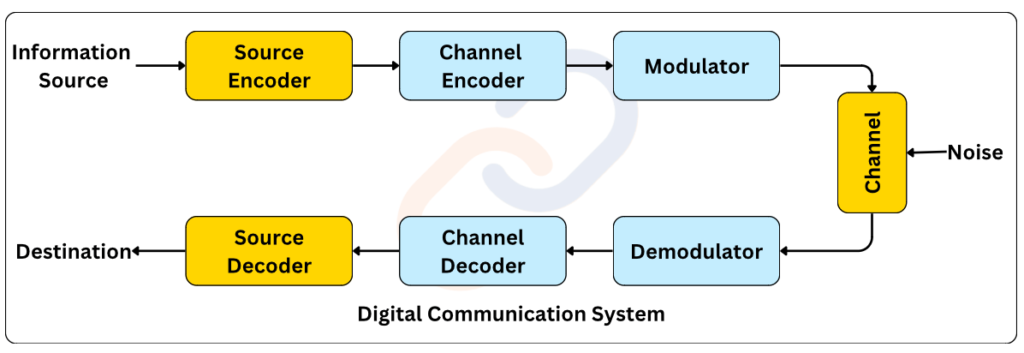
Digital Modulation Techniques
- Amplitude Shift Keying (ASK): Carrier wave amplitude varies with binary data.
- Applications: RFID, optical communication.
- Pros: Simple. Cons: Noise-prone.
- Frequency Shift Keying (FSK): Carrier wave frequency varies with binary data.
- Applications: Modems, telemetry.
- Pros: Better noise immunity. Cons: Higher bandwidth needed.
- Phase Shift Keying (PSK): Phase of carrier wave varies with binary data.
- Applications: Wi-Fi, Bluetooth, satellite communication.
- Pros: High data rate. Cons: Complex.
- Quadrature Amplitude Modulation (QAM): Combines amplitude and phase variations.
- Applications: LTE, DSL, cable modems.
- Pros: High data rates.
- Cons: Needs high SNR.
Advantages of Digital Communication
- Noise Immunity: Resilient to interference; uses error correction.
- Bandwidth Efficiency: Advanced techniques (e.g., QAM) maximize data transmission.
- Ease of Processing: Enables compression, encryption, and manipulation.
- Error Detection and Correction improve reliability.
- Scalability: Supports IoT, cloud computing, and modern technologies.
Disadvantages of Digital Communication
- High Complexity: Needs advanced algorithms for encoding, decoding, and synchronization.
- High Initial Cost: Infrastructure setup (e.g., fiber optics, 5G) is expensive.
- Synchronization Issues: Accurate timing is critical to avoid errors.
Applications of Digital Communication
- Internet: Backbone for data transfer, streaming, and browsing.
- Mobile Networks: Used in GSM, 3G, 4G, and 5G systems.
- Broadcasting: Digital TV and radio offer better quality and features.
- Data Storage: Integral to USB drives, hard disks, and cloud systems.
- Satellite Communication: Enables high-speed data transmission.
| Aspect | Analog Communication | Digital Communication |
| Signal Type | Continuous signal that varies in amplitude or frequency. | Discrete signal represented as binary (0s and 1s). |
| Representation | Uses waveforms to represent data. | Uses digital codes (binary format). |
| Noise Resistance | Highly susceptible to noise and interference, leading to signal degradation. | Strong resistance to noise, maintains signal quality. |
| Data Transmission | Suitable for transmitting simple data like voice or sound. | Suitable for transmitting complex data like multimedia and text. |
| Quality Over Distance | Quality decreases significantly as distance increases. | Quality remains consistent over long distances. |
| Hardware Complexity | Simpler hardware but less efficient. | Complex hardware but more efficient and reliable. |
| Bandwidth Utilization | Requires more bandwidth due to the continuous nature of the signal. | Requires less bandwidth for the same data. |
| Error Detection/Correction | Limited capability for error detection and correction. | Advanced error detection and correction mechanisms. |
| Storage | Data cannot be stored easily or manipulated without degradation. | Digital data is easy to store, process, and manipulate. |
| Coding | Analog signals cannot be coded easily. | Digital signals can be encoded using techniques like ASCII, Huffman, or binary codes. |
| Encryption | Limited encryption; less secure for sensitive data. | Advanced encryption techniques like AES, RSA ensure secure communication. |
| Repeater Use | Amplifiers are used but amplify noise along with the signal. | Digital repeaters regenerate the signal, reducing noise and maintaining quality. |
| Types of Modulation | Amplitude Modulation (AM), Frequency Modulation (FM), Phase Modulation (PM). | Amplitude Shift Keying (ASK), Frequency Shift Keying (FSK), Phase Shift Keying (PSK). |
| Power Requirement | Requires more power due to continuous signals. | Requires less power, especially for long-distance transmission. |
| Examples | AM/FM Radio, analog TVs, landline telephones. | Mobile phones, digital TVs, internet, emails. |
FAQ (Previous year questions)
(b) Draw a schematic diagram showing the (i) Ground wave, (ii) Sky wave, (iii) Space wave propagation of electromagnetic waves.
(c) Write the frequency range for each of the following :
(i) Standard Amplitude Modulated (AM) Broadcast
(ii) Television
(iii) Satellite Communication (Marks – 10 M, 2024)
(a) Distinguish between “Sky wave” and “Space wave” propagation
Aspect
Sky wave
Space wave
Definition
Involves the Reflection and refraction of radio waves from the ionosphere to reach distant locations.
Involves direct transmission of waves from the transmitting antenna to the receiving antenna, either directly or by line-of-sight.
Frequency Range
3 MHz – 30 MHz.
30 MHz – 300 MHz.
Distance
Long-range (hundreds/thousands of km)
Short to medium-distance transmission (Limited to the line-of-sight range).
Application
Long-range communication (e.g., international broadcasting, radio communication).
Short-range communication (e.g., mobile phones, Wi-Fi, TV broadcasting, satellite communication).
Effect of Terrain
Less affected by terrain
Can be blocked by obstacles (e.g., mountains, buildings), Requires clear line of sight
Signal Strength
Affected by ionosphere conditions and solar activity.
Diminishes with distance.
(b)
(c)
Frequency Range
Standard Amplitude Modulated (AM) Broadcast
540-1600 kHz
Television
VHF (54-72 MHz, 76-88 MHz) & UHF (174-216 MHz, 420-890 MHz)
Satellite Communication
5.925-6.425 GHz (Uplink), 3.7-4.2 GHz (Downlink)
Aspect
Analog Signals
Digital Signals
Definition
Continuous signal that represents data through varying amplitude, frequency, or phase.
Discrete signal that encodes data in binary form (0s and 1s).
Representation
Represented as a sine wave or any continuous waveform.
Represented as square waves.
Nature
Continuous and can have infinite values.
Discrete and has only a finite number of values.
Noise Sensitivity
Highly sensitive to noise; noise directly alters the signal.
Less sensitive to noise; errors can often be corrected.
A communication system is a setup or network that enables the exchange of information (data, voice, video, etc.) between a sender and a receiver using a specific medium (wired or wireless) and protocol. The primary goal of any communication system is to ensure that the transmitted information is received with minimal distortion and maximum accuracy.
Elements of a Communication system
Information Source: Generates the original message or data to be transmitted. Examples: Human voice in a phone call.
Transmitter: The transmitter is responsible for converting the information into a signal that can be transmitted through a medium. Processes in a Transmitter:
Transducer → Modulation → Oscillator → Amplification → Signal radiation through Antenna.
Communication Channel: The medium through which the signal travels from the transmitter to the receiver. Types of communication channels:
Wired Channels: Use physical connections like copper cables, optical fibers, or coaxial cables. Example: LAN Ethernet cables.
Wireless Channels: Use electromagnetic waves (radio, microwave, infrared). Example: Wi-Fi, mobile networks.
Receiver: Recovers the original message from the transmitted signal. Processes in a Receiver:
Demodulation: Separates the message signal from the carrier wave.
Decoding: Converts the received signal back into its original form (e.g., sound, text, or video).
Destination: The final endpoint where the information is delivered. Examples: A person listening to a phone call.
